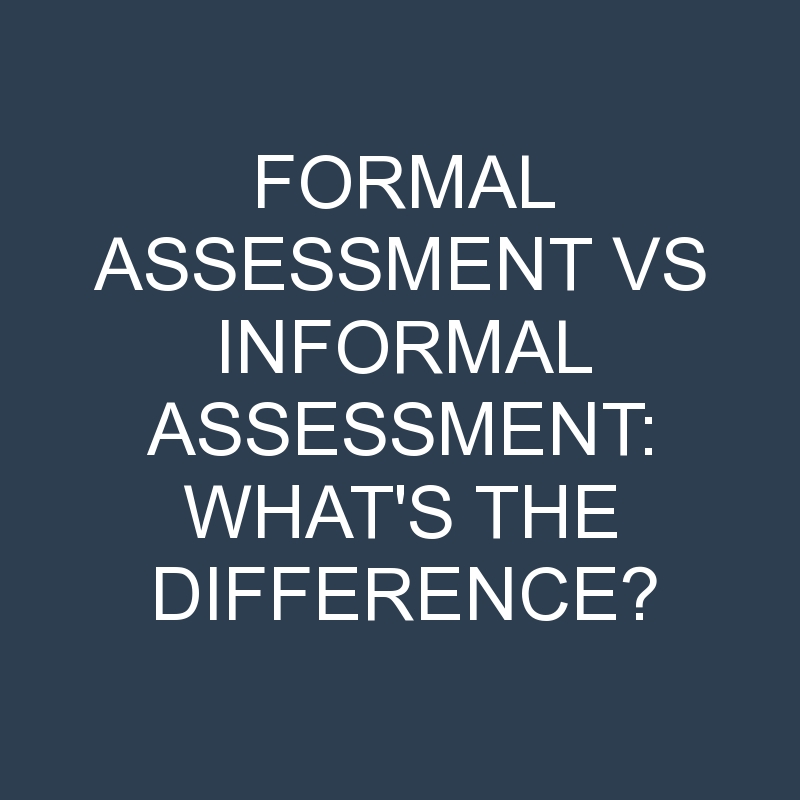Post Contents
Formal Assessment Vs Informal Assessment: What’s the Difference?
Formal assessment is a common way to measure the quality of student work. It involves a set of specific tasks that are designed to evaluate the student’s ability to meet academic standards. On the other hand, informal assessment is a less formal way of measuring student progress and learning. It involves observations and feedback from educators and peers instead of specific tasks.
What is Formal Assessment?
Formal assessment is a process used in educational institutions to evaluate the achievement of students. The assessment typically takes the form of a test or an assignment.
Informal assessment is a process used by teachers to evaluate the achievement of students. The assessment typically takes the form of conversations with students and observations of their behavior.
What is Informal Assessment?
Informal assessment is a process used by educators to collect data about students’ academic progress. Informal assessment can be done through questioning, observations, or interviews. The goal of informal assessment is to obtain information that can help educators make decisions about a student’s academic progress and potential.
The Benefits of Formal Assessment
Formal assessment is a process where a teacher gathers objective data about a student’s academic performance. This data can be used to make better decisions about the student’s instruction. Formal assessment also provides teachers with valuable information about their students’ progress and ability.
In contrast, informal assessment is a process where a teacher relies on his or her own judgment about a student’s academic performance. Informal assessment is often less reliable because it is based on the teacher’s interpretation of the student’s performance. Consequently, teachers may overestimate or underestimate a student’s achievement.
There are several advantages to using formal assessment procedures over informal assessment procedures. First, formal assessment provides teachers with accurate information about their students’ academic progress. Second, using formal assessment procedures allows teachers to target specific instructional interventions to improve student performance. Finally, using formal assessment procedures can help schools identify and address areas of strength and weakness in their curriculum.
When should I use formal or informal assessments?
There is no one answer to this question since each situation will be different. However, some factors to consider when making the decision whether to use formal or informal assessments include: the type of curriculum being taught; the level of difficulty of the material being covered;
The Benefits of Informal Assessment
Informal assessment is a way of assessing employees that is not as formal as a traditional assessment. There are many benefits to using informal assessment methods, such as being more flexible and adaptable, providing better feedback, and being less expensive.
One of the best benefits of informal assessment is that it is more flexible. With traditional assessments, there are certain criteria that must be met for an employee to be considered for a promotion or award. However, with informal assessments, these criteria can be more subjective and based on the individual’s performance. This allows for greater diversity in the workplace and better promotes creativity and innovation. In addition, informal assessments can be adapted to different situations and circumstances which makes them very versatile.
Another benefit of informal assessment is that it provides better feedback. With traditional assessments, employees may not always receive accurate or honest feedback. This can lead to frustration and decreased productivity. However, with informal assessments, employees are able to receive feedback that is tailored to their individual needs. This means that they will be able to learn from their mistakes and improve their skills faster than if they received inaccurate feedback from a traditional assessment.
In addition, informal assessments are less expensive than traditional assessments
When to Use Formal Assessment
Formal assessment is most often used when the goal is to produce an accurate and reliable report. Informal assessment, on the other hand, is more often used when the goal is to develop a consensus or understanding about a situation. Formal assessment may also be more time-consuming, but it can provide a more accurate and reliable report.
When to Use Informal Assessment
There is a lot of confusion about when to use formal and informal assessment. Formal assessment is when an evaluator uses specific, standardized tools or measures to evaluate a student’s academic progress or achievement. Informal assessment, on the other hand, is any type of assessment that isn’t formally standardized. This can include things like teacher observations, interviews, and focus groups.
There are pros and cons to each approach. Formal assessments are usually more accurate and provide a more complete picture of a student’s academic progress. However, they can be time-consuming and expensive, so they may not be feasible for all schools or situations. Informal assessments are cheaper and faster, but they may not provide as complete a picture of a student’s academic performance.
Conclusion
Formal assessment vs informal assessment: what’s the difference?
Informal assessment is a process that allows for more personal interaction between assessor and individual being assessed. It’s also common to use less formal documentation, such as interviews or focus groups, which can make it more “user-friendly” for people who are assessing. Formal assessments typically take longer to complete but often provide a higher level of accuracy and precision.
